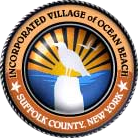

ANIMAL MANAGEMENT
For information about who to contact regarding injured wildlife, please see: Keep Wildlife Wild. Also, for anyone interested there is an app called Animal Help Now that can be downloaded to find local assistance for any wildlife rescue.
Deer, raccoons, feral cats, foxes, toads, turtles, and birds: they are all part of the landscape here because we are all part of the same eco-system. We are committed to educating our community in the ways of managing them in an ethical and humane way.
Deer
One of the most delightful experiences of Fire Island is seeing deer grazing along the sidewalk. But remember, DO NOT FEED THE DEER, no matter how appealing they may be. It encourages them to rely on handouts, and artificially increases their numbers, dooming them to starve to death in severe winters. In this case, it is cruel to be kind!
» click here to download our "Please Don't Feed The Deer" color poster
Feral Cats
Ocean Beach has a significant population of stray and feral cats and kittens, as do many communities on Fire Island. This is the result of people abandoning unsterilized pets that have then gone on to reproduce unfettered for decades. In order to control and ultimately reduce this population, local non-profits and volunteers practice Trap-Neuter-Return or TNR, which includes sterilization, vaccination, and ear tipping to identify spayed and neutered cats. The feral cats are then cared for in managed colonies by local volunteers who provide food and water as well as winter shelter. In addition to improving the health and welfare of the feral cats and removing adoptable cats, TNR reduces nuisance behaviors of unneutered cats, including fighting, yowling, and spraying. Over the past five years, more than 150 cats have been spayed and neutered in Ocean Beach and Seaview alone. There are organizations currently raising funds to expand TNR in Ocean Beach to reduce the growing feral and stray cat population, and specifically for discounted medical care at Farmingdale Dog & Cat Clinic; transportation to and from the facility; dedicated trapping equipment for Ocean Beach, including drop traps, snap traps, and transfer cages; and food and feeders to maintain the TNR colonies, particularly during the winter.
Please be sure to include "Ocean Beach" in the memo field of the check to indicate that the funds are restricted for use in Ocean Beach only.
Fixing Felines of Islip Township
PO Box 94
Islip Terrace, NY 11752
Raccoons
Raccoons are fun to watch as well, but not so much fun if they decide to set up housekeeping in your chimney or in your house. Don't be surprised if you don't see them very often. They are nocturnal, which means they are most active at night. Secure your garbage to avoid attracting raccoons.
» click here to read about humane ways to keep raccoons out of your house
Foxes
The fox population in Ocean Beach has declined recently from its peak a few years ago. Fox are omnivores, existing primarily on rodents and insects.
Horse Shoe Crabs
On nights of full and new moon in April and May, when tides are highest, horse show crabs appear on our beaches to spawn. To find out more about this ancient creature-which is not a crab at all-go to oceanservice.noaa.gov/facts/horseshoe-crab.html
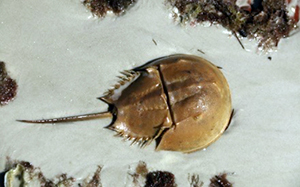
Toads
Toads are wonderful to watch, and not uncommon on Fire Island. They are great to have around because they eat what most people consider pests: flies, mosquitoes, and slugs. Did you know you could make your yard more receptive to toads?
» click here to find out how
Birds
As part of Fire Island National Seashore, Ocean Beach is a birder's paradise. Because we are located along the Atlantic flyway, more than 330 species have been recorded on Fire Island, about a third of all species found in North America! This would include both resident and migrant birds. Fire Island is one of the best birding locations in the New York area, especially during the spring and fall migrations.
Two endangered and threatened bird species are known to nest within Ocean Beach: the piping plover and roseate tern. Fire Island National Seashore's piping plover monitoring and protection program begins in March with a restriction on driving, pets and kites on portions of the beach. Symbolic fencing is installed to mark suitable plover habitat.
The population of piping plover in New York (all of which breed along our shoreline) declined from 457 pairs in 2007 to 286 pairs in 2014, but has since rebounded to 381 pairs in 2016. In 2016, only 1,941 pairs of piping plovers existed worldwide and the piping plover remained vulnerable to extinction under the Endangered Species Act.
Sharks
Sharks play an important role in keeping our ocean healthy. From our shores on Fire Island, we can see Atlantic blacktips, basking, blue, sand tigers, dogfish, mako, threshers, spinners, and sometimes even a great white! While none of these species are known for feeding on humans, the Ocean Beach Lifeguards have taken some extra precautions since the rise in shark sightings. They now conduct daily drone surveys of the water, as well as surveys with a new Sea-Doo watercraft, they have increased the distance between swimming and fishing areas and have implemented a new all-island communication protocol as per the Fire Island National Seashore. The lifeguards themselves have even taken an additional precaution of wearing Sharkbanz, magnetic bands that deter sharks by generating a powerful electromagnetic field that interferes with the shark's use of electroreception. Not to worry: this does not harm sharks or any other marine life. And don't forget to report shark sightings using this QR Code:
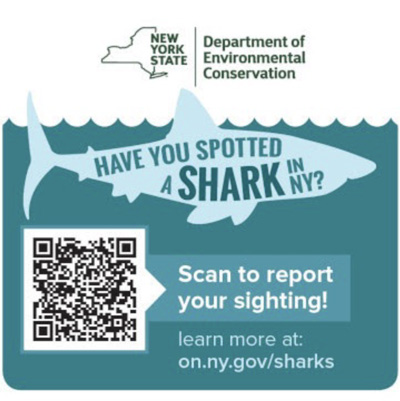
Whales
There are six large whale species that can be found in New York's marine waters: the humpback, sperm whale, blue whale, North American right whale, fin whale and sei whale. They are all considered endangered except for the humpback whale. See Marine Mammals of New York - NYS Dept. of Environmental Conservation for summary information about the size, lifespan, diet, and status (endangered or not) of each of these species.
Whale migratory patterns are complex, as well as species and location specific. For example, there are 14 distinct populations of humpback whales world-wide. In the North Atlantic, two populations of humpback whales feed during spring, summer, and fall throughout a range that extends across the Atlantic Ocean from the Gulf of Maine to Norway. These two populations migrate south during the winter to calve and mate in the West Indies and Cape Verde (off the coast of Africa), and possibly in other areas. Humpback whales swim close to shore off Fire Island and often display activities near the surface, such as breaching (jumping out of the water) or slapping the surface with their pectoral fins and tails. See Humpback Whale | NOAA Fisheries for more information about humpback whales.
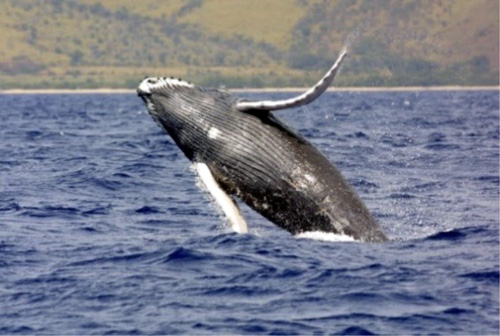
Humpback whale breaching. Credit: NOAA Fisheries
In contrast with the humpback whale, the North Atlantic right whale is critically endangered and primarily occurs in Atlantic coastal waters on the continental shelf, although they also are known to travel far offshore, over deep water. Right whales migrate seasonally and may travel alone or in small groups. In the spring, summer, and into fall, many of these whales can be found in waters off New England and further north into Canadian waters, where they feed and mate. Occasionally, they can be detected in the waters off Long Island. [Note: In the early '80s, a right whale glided slowly into the swimming area of Ocean Beach and proceeded to move slowly over the next month out east to Montauk Point, along with a sea turtle companion]. It is estimated that there are now fewer than 350 North Atlantic right whales and fewer than 70 female right whales. For more information click on North Atlantic Right Whale | NOAA Fisheries.
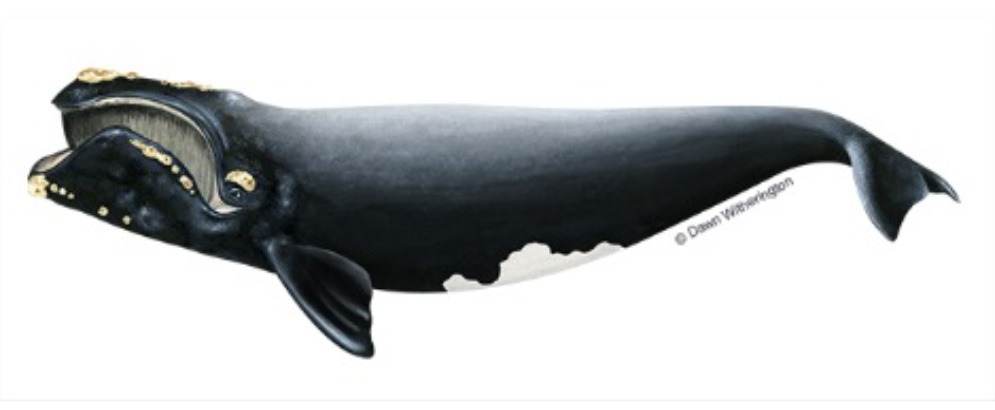
Northern Right Whale
Each fall, some right whales travel more than 1,000 miles from these feeding grounds to the shallow, coastal waters of their calving grounds off South Carolina, Georgia, and northeastern Florida, though migration patterns vary. NOAA Fisheries has designated two areas as critical habitat for North Atlantic right whales. These areas provide important feeding, nursery, and calving habitat:
Those interested in learning more about the frequency of detection through passive acoustic sonar methods of individual whale species should check out the following interactive web tool an example of whose data visualization output is provided below Track Whale Detections With This Interactive Map | NOAA Fisheries.

Other Wildlife
Marine Mammals
Fire Island residents who have been living or summering on the island for a long time may have noticed the increased number of sightings of marine mammals. And it is always exciting to see a whale breaching the surface of the water or a pod of dolphins racing through nearby waters, as in times past. Two groups of marine mammals inhabit our coastal waters: cetaceans (whales, dolphins, and porpoises) and pinnipeds (seals). From harbor seals on the shores of southeastern Long Island in the winter to humpback whales feeding just off of New York City in the summer, marine mammals can be found in New York's coastal waters year-round. While it is exciting to see the marine mammals in their native environment, and sometimes in the case of seals, when they get close to shore, or sunbath or rest on the beach, it is important for the public to understand that all whales, dolphins, porpoises, and seals, are protected by federal and state laws to help conserve the species, ensure they are not harmed and to keep people at a safe distance.
According to the NYSDEC, up to five species of seals can be seen locally, but harbor, gray, and harp seals are the most common. Many of the 90 species of whales, dolphins, and porpoises can be found in New York marine waters - some regularly and some very rarely. To learn more about the status (endangered or not), diet, size, and life span of the six large whale species found in New York marine waters (humpback, sperm whale, blue whale, North American right whale, fin whale and sei whale) and the most commonly seen species of dolphins and porpoises visit Marine Mammals of New York - NYS Dept. of Environmental Conservation. Those interested in learning more about State efforts to survey and census the various marine mammals visiting our waters, through aerial and acoustic surveys, should visit New York Bight Whale Monitoring Program - NYS Dept. of Environmental Conservation. Scientists at NOAA's Northeast Fisheries Science Center have created a new data mapping tool ( Passive Acoustic Cetacean Map | NOAA NEFSC ) to help people understand when and where large whales occur off the East Coast.
Citizen scientists can help the DEC better understand marine mammal distribution in New York Waters, by reporting general sightings of marine mammals to DEC's Flipper Files digital survey. And if you see a marine mammal in distress or wash ashore, contact the 24-hour New York State Marine Mammal and Sea Turtle Stranding Hotline immediately at (631) 369-9829 and relay as much information about the animal and its location as possible. The hotline is monitored by the Atlantic Marine Conservation Society (AMSEAS) and New York Marine Rescue Center (NYMRC) which are federally permitted and trained to handle marine mammals and administer professional medical care.
If you observe an individual harassing or endangering New York's marine life, contact DEC Environmental Conservation Police Officers (ECOs) to report the incident by calling 1-844-DEC-ECOS for 24-hour dispatch or emailing central.dispatch@dec.ny.gov (for non-urgent violations)
Along with increased sightings of marine mammals, there have been a spate of reports in the news media about instances of dead whales washing up on the beaches off of Long Island and New Jersey. See for example... ( Why 23 Dead Whales Have Washed Up on the East Coast Since December - The New York Times (nytimes.com). There are a number of possible explanations for death, injury or disease in the marine mammal population, but one significant reason has been injury due to interaction with marine vessels both large and small. It is important therefore, for all boaters, including recreational boaters to understand federal and state regulations.
Federal law requires vessels to stay:
Sea Turtles
As water temperatures begin to rise in late spring and early summer, the waters of New York become more suitable for sea turtles. During these warm months, four species of sea turtles can be found: green, Kemp's ridley, leatherback and loggerhead sea turtle. They remain local to New York from approximately May through November and are particularly fond of the warmer waters in coastal bays and the Long Island Sound. By the end of November, they begin their migration south to warmer nesting waters. For more information on Sea Turtles see Sea Turtles of New York - NYS Dept. of Environmental Conservation.
Sea turtles that come onshore in New York are likely cold-stunned and need medical attention. Immediately call the Stranding Hotline (631) 369-9829 and relay as much information as possible. If you leave a voice message, be sure to include very specific directions and information, as well as your name and phone number so the responders can reach you if they have any questions. Do not put the turtle back in the water or touch the animal. These are federally protected animals and are only to be handled by authorized personnel. Cold-stunned sea turtles are lethargic; they can easily drown if placed back in the water. Any further sudden changes in temperature can lead to death.
VOBEC is a mayor-appointed commission whose purpose is to preserve and improve the quality of the natural and man-made environment within the Village in the face of population growth, urbanization, and technological change and their subsequent demands on natural resources. These areas of focus reflect this mission of maintaining and improving the quality of our life experience and our efforts to foster unified action on environmental problems.
Deer, raccoons, feral cats, foxes, toads, turtles, and birds: they are all part of the landscape here because we are all part of the same eco-system. We are committed to educating our community in the ways of managing them in an ethical and humane way.
Deer
One of the most delightful experiences of Fire Island is seeing deer grazing along the sidewalk. But remember, DO NOT FEED THE DEER, no matter how appealing they may be. It encourages them to rely on handouts, and artificially increases their numbers, dooming them to starve to death in severe winters. In this case, it is cruel to be kind!
» click here to download our "Please Don't Feed The Deer" color poster
Feral Cats
Ocean Beach has a significant population of stray and feral cats and kittens, as do many communities on Fire Island. This is the result of people abandoning unsterilized pets that have then gone on to reproduce unfettered for decades. In order to control and ultimately reduce this population, local non-profits and volunteers practice Trap-Neuter-Return or TNR, which includes sterilization, vaccination, and ear tipping to identify spayed and neutered cats. The feral cats are then cared for in managed colonies by local volunteers who provide food and water as well as winter shelter. In addition to improving the health and welfare of the feral cats and removing adoptable cats, TNR reduces nuisance behaviors of unneutered cats, including fighting, yowling, and spraying. Over the past five years, more than 150 cats have been spayed and neutered in Ocean Beach and Seaview alone. There are organizations currently raising funds to expand TNR in Ocean Beach to reduce the growing feral and stray cat population, and specifically for discounted medical care at Farmingdale Dog & Cat Clinic; transportation to and from the facility; dedicated trapping equipment for Ocean Beach, including drop traps, snap traps, and transfer cages; and food and feeders to maintain the TNR colonies, particularly during the winter.
Please be sure to include "Ocean Beach" in the memo field of the check to indicate that the funds are restricted for use in Ocean Beach only.
Fixing Felines of Islip Township
PO Box 94
Islip Terrace, NY 11752
Raccoons
Raccoons are fun to watch as well, but not so much fun if they decide to set up housekeeping in your chimney or in your house. Don't be surprised if you don't see them very often. They are nocturnal, which means they are most active at night. Secure your garbage to avoid attracting raccoons.
» click here to read about humane ways to keep raccoons out of your house
Foxes
The fox population in Ocean Beach has declined recently from its peak a few years ago. Fox are omnivores, existing primarily on rodents and insects.
Horse Shoe Crabs
On nights of full and new moon in April and May, when tides are highest, horse show crabs appear on our beaches to spawn. To find out more about this ancient creature-which is not a crab at all-go to oceanservice.noaa.gov/facts/horseshoe-crab.html

Toads
Toads are wonderful to watch, and not uncommon on Fire Island. They are great to have around because they eat what most people consider pests: flies, mosquitoes, and slugs. Did you know you could make your yard more receptive to toads?
» click here to find out how
Birds
As part of Fire Island National Seashore, Ocean Beach is a birder's paradise. Because we are located along the Atlantic flyway, more than 330 species have been recorded on Fire Island, about a third of all species found in North America! This would include both resident and migrant birds. Fire Island is one of the best birding locations in the New York area, especially during the spring and fall migrations.
Two endangered and threatened bird species are known to nest within Ocean Beach: the piping plover and roseate tern. Fire Island National Seashore's piping plover monitoring and protection program begins in March with a restriction on driving, pets and kites on portions of the beach. Symbolic fencing is installed to mark suitable plover habitat.
The population of piping plover in New York (all of which breed along our shoreline) declined from 457 pairs in 2007 to 286 pairs in 2014, but has since rebounded to 381 pairs in 2016. In 2016, only 1,941 pairs of piping plovers existed worldwide and the piping plover remained vulnerable to extinction under the Endangered Species Act.
Sharks
Sharks play an important role in keeping our ocean healthy. From our shores on Fire Island, we can see Atlantic blacktips, basking, blue, sand tigers, dogfish, mako, threshers, spinners, and sometimes even a great white! While none of these species are known for feeding on humans, the Ocean Beach Lifeguards have taken some extra precautions since the rise in shark sightings. They now conduct daily drone surveys of the water, as well as surveys with a new Sea-Doo watercraft, they have increased the distance between swimming and fishing areas and have implemented a new all-island communication protocol as per the Fire Island National Seashore. The lifeguards themselves have even taken an additional precaution of wearing Sharkbanz, magnetic bands that deter sharks by generating a powerful electromagnetic field that interferes with the shark's use of electroreception. Not to worry: this does not harm sharks or any other marine life. And don't forget to report shark sightings using this QR Code:

Whales
There are six large whale species that can be found in New York's marine waters: the humpback, sperm whale, blue whale, North American right whale, fin whale and sei whale. They are all considered endangered except for the humpback whale. See Marine Mammals of New York - NYS Dept. of Environmental Conservation for summary information about the size, lifespan, diet, and status (endangered or not) of each of these species.
Whale migratory patterns are complex, as well as species and location specific. For example, there are 14 distinct populations of humpback whales world-wide. In the North Atlantic, two populations of humpback whales feed during spring, summer, and fall throughout a range that extends across the Atlantic Ocean from the Gulf of Maine to Norway. These two populations migrate south during the winter to calve and mate in the West Indies and Cape Verde (off the coast of Africa), and possibly in other areas. Humpback whales swim close to shore off Fire Island and often display activities near the surface, such as breaching (jumping out of the water) or slapping the surface with their pectoral fins and tails. See Humpback Whale | NOAA Fisheries for more information about humpback whales.

Humpback whale breaching. Credit: NOAA Fisheries
In contrast with the humpback whale, the North Atlantic right whale is critically endangered and primarily occurs in Atlantic coastal waters on the continental shelf, although they also are known to travel far offshore, over deep water. Right whales migrate seasonally and may travel alone or in small groups. In the spring, summer, and into fall, many of these whales can be found in waters off New England and further north into Canadian waters, where they feed and mate. Occasionally, they can be detected in the waters off Long Island. [Note: In the early '80s, a right whale glided slowly into the swimming area of Ocean Beach and proceeded to move slowly over the next month out east to Montauk Point, along with a sea turtle companion]. It is estimated that there are now fewer than 350 North Atlantic right whales and fewer than 70 female right whales. For more information click on North Atlantic Right Whale | NOAA Fisheries.

Northern Right Whale
Each fall, some right whales travel more than 1,000 miles from these feeding grounds to the shallow, coastal waters of their calving grounds off South Carolina, Georgia, and northeastern Florida, though migration patterns vary. NOAA Fisheries has designated two areas as critical habitat for North Atlantic right whales. These areas provide important feeding, nursery, and calving habitat:
- Off the coast of New England (foraging area)
- Off the southeast U.S. coast from Cape Fear, North Carolina, to below Cape Canaveral, Florida (calving area)
Those interested in learning more about the frequency of detection through passive acoustic sonar methods of individual whale species should check out the following interactive web tool an example of whose data visualization output is provided below Track Whale Detections With This Interactive Map | NOAA Fisheries.

Other Wildlife
Marine Mammals
Fire Island residents who have been living or summering on the island for a long time may have noticed the increased number of sightings of marine mammals. And it is always exciting to see a whale breaching the surface of the water or a pod of dolphins racing through nearby waters, as in times past. Two groups of marine mammals inhabit our coastal waters: cetaceans (whales, dolphins, and porpoises) and pinnipeds (seals). From harbor seals on the shores of southeastern Long Island in the winter to humpback whales feeding just off of New York City in the summer, marine mammals can be found in New York's coastal waters year-round. While it is exciting to see the marine mammals in their native environment, and sometimes in the case of seals, when they get close to shore, or sunbath or rest on the beach, it is important for the public to understand that all whales, dolphins, porpoises, and seals, are protected by federal and state laws to help conserve the species, ensure they are not harmed and to keep people at a safe distance.
According to the NYSDEC, up to five species of seals can be seen locally, but harbor, gray, and harp seals are the most common. Many of the 90 species of whales, dolphins, and porpoises can be found in New York marine waters - some regularly and some very rarely. To learn more about the status (endangered or not), diet, size, and life span of the six large whale species found in New York marine waters (humpback, sperm whale, blue whale, North American right whale, fin whale and sei whale) and the most commonly seen species of dolphins and porpoises visit Marine Mammals of New York - NYS Dept. of Environmental Conservation. Those interested in learning more about State efforts to survey and census the various marine mammals visiting our waters, through aerial and acoustic surveys, should visit New York Bight Whale Monitoring Program - NYS Dept. of Environmental Conservation. Scientists at NOAA's Northeast Fisheries Science Center have created a new data mapping tool ( Passive Acoustic Cetacean Map | NOAA NEFSC ) to help people understand when and where large whales occur off the East Coast.
Citizen scientists can help the DEC better understand marine mammal distribution in New York Waters, by reporting general sightings of marine mammals to DEC's Flipper Files digital survey. And if you see a marine mammal in distress or wash ashore, contact the 24-hour New York State Marine Mammal and Sea Turtle Stranding Hotline immediately at (631) 369-9829 and relay as much information about the animal and its location as possible. The hotline is monitored by the Atlantic Marine Conservation Society (AMSEAS) and New York Marine Rescue Center (NYMRC) which are federally permitted and trained to handle marine mammals and administer professional medical care.
If you observe an individual harassing or endangering New York's marine life, contact DEC Environmental Conservation Police Officers (ECOs) to report the incident by calling 1-844-DEC-ECOS for 24-hour dispatch or emailing central.dispatch@dec.ny.gov (for non-urgent violations)
Along with increased sightings of marine mammals, there have been a spate of reports in the news media about instances of dead whales washing up on the beaches off of Long Island and New Jersey. See for example... ( Why 23 Dead Whales Have Washed Up on the East Coast Since December - The New York Times (nytimes.com). There are a number of possible explanations for death, injury or disease in the marine mammal population, but one significant reason has been injury due to interaction with marine vessels both large and small. It is important therefore, for all boaters, including recreational boaters to understand federal and state regulations.
Federal law requires vessels to stay:
- 500 yards away from North Atlantic right whales.
- 100 yards away from all other large whales
- 50 yards away from dolphins, porpoises, seals and sea turtles
Sea Turtles
As water temperatures begin to rise in late spring and early summer, the waters of New York become more suitable for sea turtles. During these warm months, four species of sea turtles can be found: green, Kemp's ridley, leatherback and loggerhead sea turtle. They remain local to New York from approximately May through November and are particularly fond of the warmer waters in coastal bays and the Long Island Sound. By the end of November, they begin their migration south to warmer nesting waters. For more information on Sea Turtles see Sea Turtles of New York - NYS Dept. of Environmental Conservation.
Sea turtles that come onshore in New York are likely cold-stunned and need medical attention. Immediately call the Stranding Hotline (631) 369-9829 and relay as much information as possible. If you leave a voice message, be sure to include very specific directions and information, as well as your name and phone number so the responders can reach you if they have any questions. Do not put the turtle back in the water or touch the animal. These are federally protected animals and are only to be handled by authorized personnel. Cold-stunned sea turtles are lethargic; they can easily drown if placed back in the water. Any further sudden changes in temperature can lead to death.
VOBEC is a mayor-appointed commission whose purpose is to preserve and improve the quality of the natural and man-made environment within the Village in the face of population growth, urbanization, and technological change and their subsequent demands on natural resources. These areas of focus reflect this mission of maintaining and improving the quality of our life experience and our efforts to foster unified action on environmental problems.
